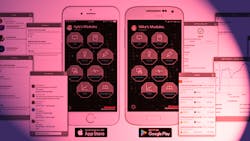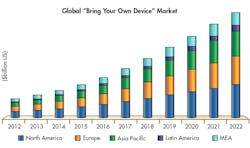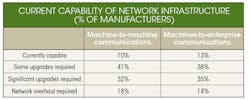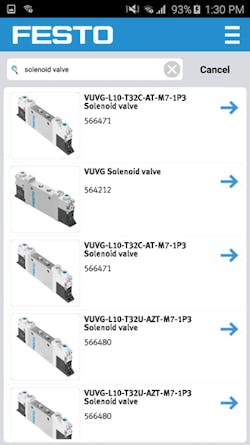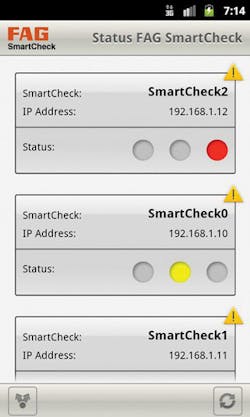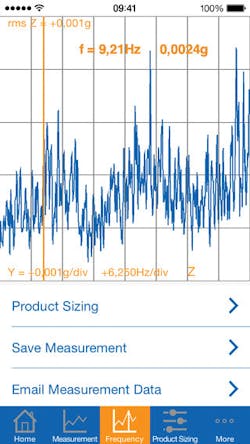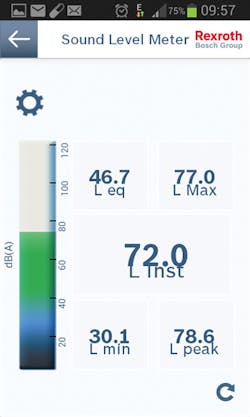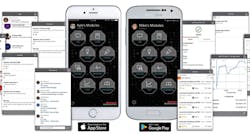Why Are Top Industrial Companies Designing Mobile Apps?
This file type includes high resolution graphics and schematics when applicable.
Smartphones and tablets have become everyday tools for many people, including engineers. These days, you simply don’t leave home without one.
In the past, many companies placed restrictions on personal devices, limiting their use and connectivity to company enterprise networks. However, adoption rates of smart devices have forced companies to become more accepting of employees using their own personal devices for business, even taking the next step of designing apps for their users. The capabilities of these apps vary, but some companies have started to push the boundaries of what these apps can do, turning the devices into fully functional work tools.
Enterprise Networks and Mobile Devices on the Rise
It comes as no surprise that many top industrial companies are releasing more mobile apps designed to work with off-the-shelf mobile devices. A recent report from MarketStudyReports.com forecasts the “bring your own device” (BYOD) market to reach $350 billion by 2022.
Increased use of tablets and smartphone penetration into the professional workplace is driving up production of mobile-device management software. Since most devices now function in both personal and professional settings, mobile-device management plays a key role in deploying, monitoring, integrating, and managing these devices in the workplace. As stated in the report from Cisco, “The real challenge for IT is not only getting devices onto the network—it’s what to do with them once they’re there.”
The capabilities of these apps will vary based on the current infrastructures. Some apps provide simple product catalogs or design guides. While these apps are useful to an engineer as a resource, they are not designed to take advantage of growing enterprise networks. Some apps actually could exploit these networks, but the telecommunication infrastructures of manufacturers need to be developed to utilize the power of mobile devices.
Many of the current plants and engineering sites today do not have a developed network infrastructure. A survey conducted by the MPI Group in 2015 showed that only 10% of manufacturers have machine-to-machine communications and 13% have machines-to-enterprise communications. However, the market for smart devices will see an increase in growth. Over the next two years, 76% of manufacturers will expand the use of smart devices and/or embedded intelligence production processes.
Mobile Catalogs
The level of usefulness from company mobile apps spans a wide range. Many apps target mobile apps to bring their product catalog and resources to your smartphone. These apps offer insights to their products as well as a way to quickly and securely order these products. While these apps are somewhat limited in their network connectivity, they offer value by connecting users to online catalogs faster.
GoTo Products – Bosch Rexrothâ
Bosch Rexroth’s GoTo Products app takes advantage of its GoTo Focused Delivery Program. Users can browse popular collections of products for manufacturing automation and machinery engineering. The app provides technical details on each product, allowing users to build a product list, and provides a list of local distributors to purchase the products in the user’s cart. U.S. users can even exploit the built-in eShop checkout process to order all of their parts at once.
FAST App – Festo
The Festo FAST App provides quick and easy access to the company’s FAST catalog. The app is centered around a complete line of industrial automation components that can be delivered in a same-day, three-day, or five-day timeframe. With access to more than 1,000 Festo automation components, the program enables engineers to gain access to wide of selection of inch and metric components, lower inventory costs through “Just in Time” delivery, reduce time to market for prototype and production projects, and create savings by easing up inventory demands and time to build. The parts available to users include pneumatic cylinders, pneumatic actuators, valves, valve terminals, sensors, actuators feedback, servo drives, electromechanical
Mobile Tools and Diagnostics
Companies have created mobile apps that turn a device into another piece of equipment on the plant floor. These apps offer users a way of measuring vibrations and sensor readouts by capitalizing on the built-in antennas and sensing equipment in smartphones.
FAG Smartcheck – Schaeffler
The Smartcheck from Schaeffler is a vibration sensor that can be easily mounted onto a device. The sensor uses crystal-based accelerometer structures to send out voltage signals that are interpreted to detect velocity and orientation. The sensors themselves connect to a local network via an Ethernet connection. Once on the network, you can go mobile by accessing the Smartcheck app. The app allows you to connect with any sensor on the network to see its unique IP address and the status of each machine.
VibroChecker – ACE
Smartphones typically have built-in accelerometers, which are typically used to detect when a person gets up or moves around, or when the phone is picked up for use. However, ACE’s engineers turned those accelerometers into vibration sensors. An engineer can quickly measure simple vibrations on machines and components with a frequency range of up to 50 Hz. Depending on the readout, the app can also suggest corrective courses of action by recommending dampening products designed by ACE.
iRConnect – FANUC
The apps designed by ACE and Schaeffler demonstrate how phones can be more useful for monitoring conditions. FANUC designed a similar app to communicate with its robotic controllers. The iRConnect app communicates to the FANUC robotic arms and can provide information on the number of robots in a zone, the health of the robot, cycle time, maintenance events, and axis conditions of the arm per joint.
Fit4SILENCE – Bosch Rexroth
âBosch Rexroth’s Fit4SILENCE app uses another phone function to create a handy diagnostics tool. By turning the phone’s microphone into a listening device, the app can measure noise levels at accuracy levels comparable to most professional sound-level meters. The app records a profile of the sound level in decibels over an allotted time. The app also records the sound level in a raw data format, which can be saved for further analysis. Furthermore, it suggests Bosch Rexroth products that would help reduce noise.
Network Connected Apps
Up to this point, all of the apps we have discussed serve a single function—whether that involves being a catalog for part ordering or a diagnostic tool. However, these apps have yet to exploit the potential of interconnected smart devices when introduced on the plant floor. Representing the future of apps, the FactoryTalk TeamONE from Rockwell Automation utilizes the strong connectivity features of smartphones.
FactoryTalk TeamONE – Rockwell Automation
The FactoryTalk TeamONE app is more than another diagnostic tool. The app is a smart node on the network rather than a client that connects to the server. As a result, the device module communicates directly to the devices on the network, and can directly view live data. The app offers diagnostic messages that allow users to interact with machine alarms and troubleshoot devices. It also helps team members to collaborate by connecting the primary user to other users on the same network, thus increasing team productivity and reducing mean time to repair.
Employees can choose from a variety of modules to directly view information from devices such as Allen-Bradley PowerFlex drives, or else observe the high-level health status of any EtherNET/IP device. After solving a particular problem, the lessons learned from the incident can be flagged. Then, the next time a similar problem arises, the team will be able to call up those lessons. The initial release of FactoryTalk TeamONE is available now and includes eight modules: Incident, Device Health, Teamboard, Knowledgebase, Connect, Pinboard and Chat, Connect, and Trend.
When speaking with Kyle Reissner, the mobility platform leader of Integrated Architecture at Rockwell Automation, we addressed the importance of having an app that opens up the possibilities of smart devices.
“The app can be used by anyone at any level to combine experience-based knowledge with contextual automation device data and solve problems quicker as a team, or even as an individual,” said Reissner. “We’ve heard from many of the TeamONE early adopters that engineers and maintenance team members use it to investigate issues. They also use the app to assist with new machine installation or commissioning and collaborate with colleagues without needing to connect to devices through plant-floor networks.”
When asked about whether or not investing in apps is beneficial, Reissner replied that “We believe apps can reduce the friction for all industrial workers to realize value and thus be more productive. Using an app with new innovations and approaches like FactoryTalk TeamONE can drive what we call ‘frictionless productivity gains’
“Apps can also provide new functions by tapping into the local power of the device,” he concluded. “The smartphone is really a supercomputer packed with a ton of sensors, and we’re just starting to explore those capabilities.”
This file type includes high resolution graphics and schematics when applicable.
